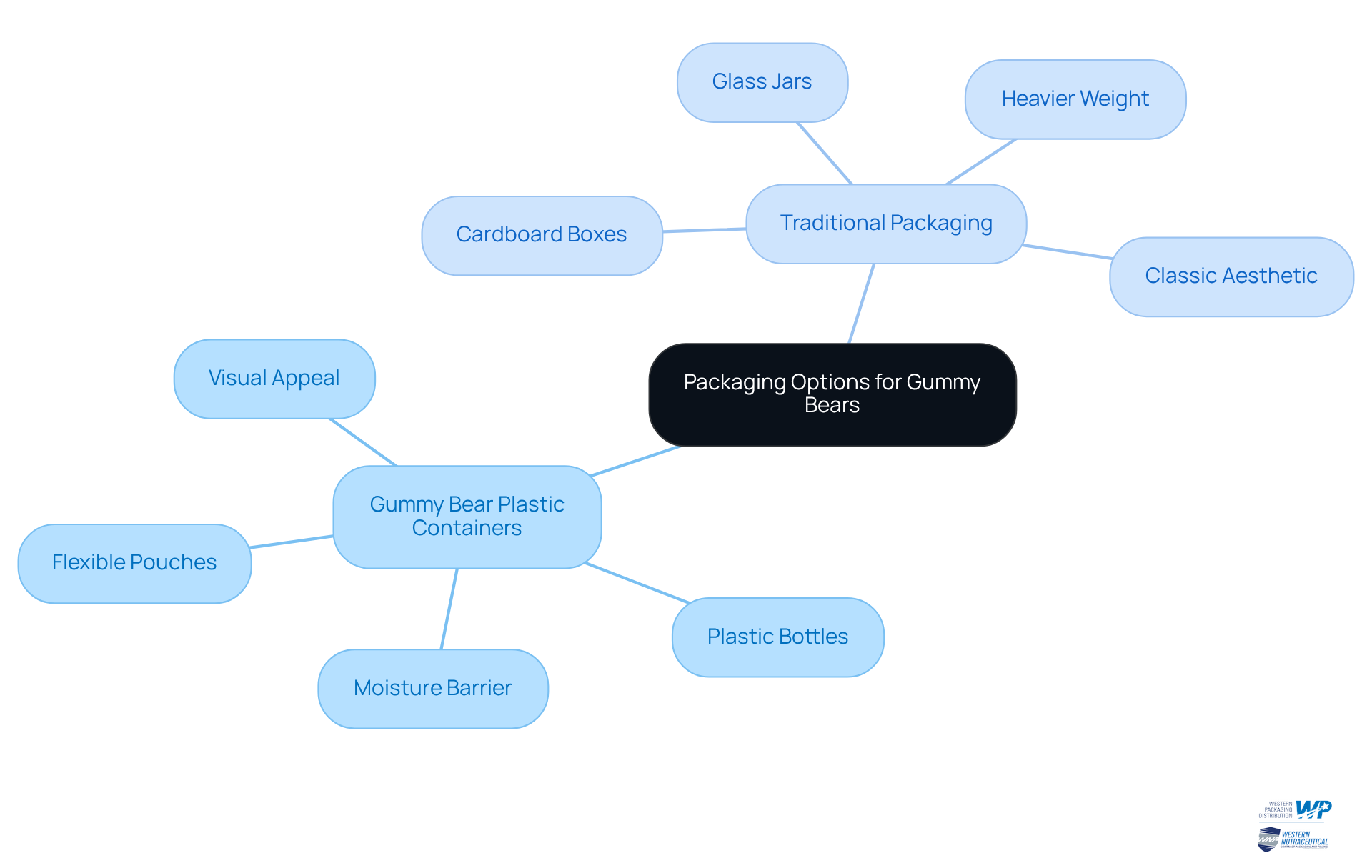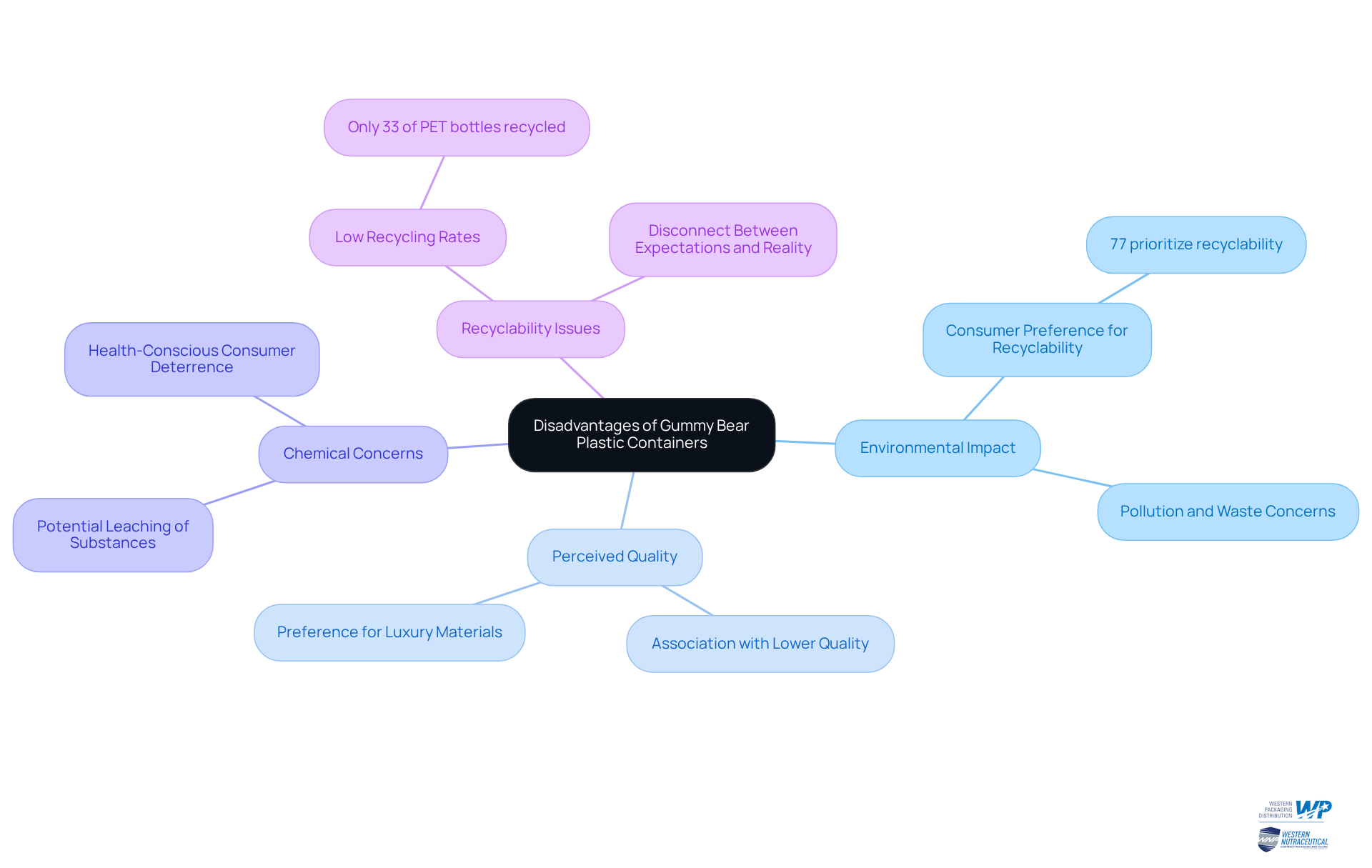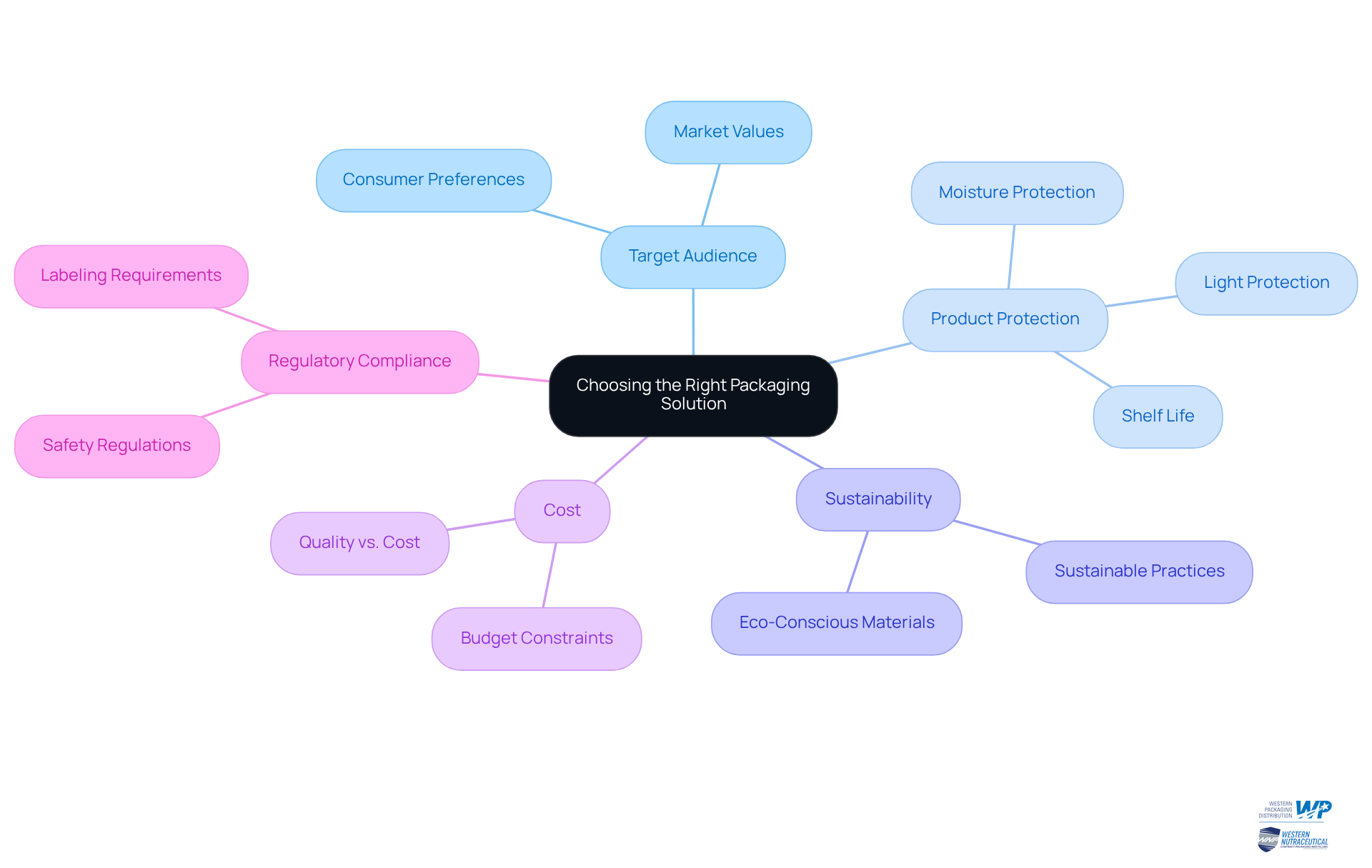Overview
This article provides an authoritative comparison of gummy bear plastic containers and traditional packaging methods, highlighting both the advantages and disadvantages inherent in each.
Plastic containers present notable benefits, including:
- Durability
- Moisture protection
- Cost-effectiveness
However, they also encounter significant challenges, such as:
- Environmental impact
- Consumer perceptions of quality
- Recycling issues
These factors necessitate careful consideration by manufacturers, especially in a market increasingly focused on sustainability. As industry professionals, it is crucial to weigh these aspects thoughtfully to align with evolving consumer expectations and regulatory standards.
Introduction
In the competitive landscape of gummy products, packaging serves as a crucial element in attracting consumers and ensuring product quality. Gummy bear plastic containers, characterized by their lightweight and moisture-resistant properties, present manufacturers with a contemporary solution that not only enhances presentation but also extends shelf life.
Yet, as sustainability concerns escalate and consumer preferences shift, the question arises: can these innovative containers genuinely rival traditional packaging methods that convey a sense of reliability and quality?
This article explores the essential insights surrounding gummy bear plastic containers in comparison to traditional options, examining their advantages, drawbacks, and the pivotal considerations manufacturers must navigate in this dynamic market.
Overview of Gummy Bear Plastic Containers and Traditional Packaging
Gummy bear plastic containers are designed with flexible pouches, plastic bottles, and jars to preserve the freshness and visual appeal of gummy products. Constructed from lightweight, durable materials, the gummy bear plastic container provides a crucial moisture barrier, essential for maintaining the chewy texture of gummies. In contrast, traditional packaging methods may utilize glass jars or cardboard boxes, which, despite offering a classic aesthetic, tend to be heavier and less effective in protecting against environmental factors.
At Western Packaging, we specialize in customized flexible containers that not only enhance product appeal but also elevate brand recognition. Our innovative packaging designs incorporate resealable closures and vibrant graphics, ensuring your gummy items stand out on the shelf while maintaining optimal freshness. Understanding these distinctions is vital for manufacturers aiming to of their offerings in a competitive market.

Advantages of Gummy Bear Plastic Containers for Nutraceuticals
Gummy bear plastic containers present numerous advantages for nutraceuticals, including:
- Durability: Plastic containers are less prone to shattering compared to glass, enhancing safety for consumers and minimizing inventory loss during shipping.
- Lightweight: This material's lightweight nature reduces shipping costs and simplifies handling for both retailers and consumers.
- Moisture Barrier: Many gummy bear plastic containers provide exceptional moisture protection, which is crucial for preserving the quality of gummy products.
- Cost-Effectiveness: Generally, plastic containers are more economical than glass or other traditional materials, enabling manufacturers to lower production costs.
- Customization: The malleability of plastic allows for easy molding into diverse shapes and sizes, granting brands the chance to design distinctive packaging that captures consumer attention on shelves.
These advantages position producers to prefer gummy bear plastic containers as a choice to and appeal to buyers.

Disadvantages of Gummy Bear Plastic Containers Compared to Traditional Options
While gummy bear plastic containers offer convenience, they also present several significant drawbacks:
- Environmental Impact: Synthetic wrappers are often condemned for their role in pollution and waste, leading an increasing number of buyers to seek sustainable options. In fact, 77% of buyers prioritize recyclability in containers, indicating a strong preference for materials that align with environmental values. As noted, "Sustainability may no longer be the loudest voice in the room, but it hasn’t been silenced."
- Perceived Quality: Many consumers associate synthetic wrapping with lower quality compared to glass or other high-end materials. This perception can influence buying choices, as consumers often gravitate toward containers that convey a sense of luxury and reliability.
- Chemical Concerns: Ongoing worries about the potential for substances to leach from materials into food products persist, particularly if the packaging is not specifically designed for food safety. This issue can deter health-conscious individuals from selecting synthetic alternatives.
- Recyclability Issues: Although some plastics are recyclable, a significant number are not, exacerbating waste and environmental challenges. In the U.S., only 33% of PET bottles are collected for recycling, highlighting a disconnect between consumer expectations and recycling capabilities. This discrepancy between technical recyclability and practical systems underscores the necessity for strategies that align with environmental goals and genuine local recycling capacities. Furthermore, 68% of respondents believe brand owners and container manufacturers should be accountable for sustainable materials.
These drawbacks underscore the necessity for manufacturers to thoroughly assess both consumer preferences and environmental consequences when selecting material options, especially when considering products like a gummy bear plastic container in a market increasingly focused on sustainability. As the landscape evolves, companies face the challenge of designing for complexity: solutions that perform across functions, appeal across segments, and deliver environmental credibility in a crowded, cost-conscious marketplace.

Key Considerations for Choosing the Right Packaging Solution
When selecting the appropriate packaging solution for gummy products, manufacturers must consider several critical factors:
- Target Audience: Understanding the preferences and values of the target market significantly influences design decisions that resonate with consumers.
- Product Protection: It is essential to assess the specific needs of the product, including moisture and light protection, to guarantee optimal shelf life and quality.
- Sustainability: Eco-conscious containers should be prioritized, aligning with consumer demand for sustainable practices and materials.
- Cost: Analyzing the cost implications of various container types is crucial, ensuring a balance between quality and budget constraints.
- Regulatory Compliance: It is vital to confirm that the chosen containers adhere to all relevant safety and labeling regulations to prevent legal complications.
By meticulously evaluating these considerations, manufacturers can identify packaging solutions like a gummy bear plastic container, which not only safeguard their products but also elevate their brand image and appeal to consumers.

Conclusion
Gummy bear plastic containers emerge as a modern alternative to traditional packaging methods, presenting unique benefits that cater to both manufacturers and consumers. These containers are lightweight and durable, providing essential moisture barriers that help maintain the quality of gummy products. As brands strive to enhance their market presence, understanding the advantages of plastic packaging becomes crucial in a competitive landscape.
This article highlights several key advantages of gummy bear plastic containers, such as:
- Cost-effectiveness
- Customization potential
- Ability to safeguard product integrity during transport
However, it also addresses significant drawbacks, including:
- Environmental concerns
- Consumer perceptions regarding quality
The discussion emphasizes the importance of balancing these factors when selecting packaging solutions, as manufacturers must navigate the complexities of sustainability, safety, and market appeal.
In conclusion, the choice between gummy bear plastic containers and traditional packaging transcends mere preference; it reflects broader trends in consumer behavior and environmental responsibility. As the demand for sustainable practices grows, manufacturers are encouraged to consider innovative packaging solutions that not only meet market needs but also align with eco-conscious values. By making informed choices, brands can enhance their product offerings while contributing to a more sustainable future in the nutraceutical industry.
Frequently Asked Questions
What are gummy bear plastic containers made from?
Gummy bear plastic containers are constructed from lightweight, durable materials that provide a crucial moisture barrier to maintain the chewy texture of gummies.
How do gummy bear plastic containers differ from traditional packaging?
Gummy bear plastic containers are designed with flexible pouches, plastic bottles, and jars, while traditional packaging methods may use glass jars or cardboard boxes, which are heavier and less effective at protecting against environmental factors.
What advantages do gummy bear plastic containers offer?
They preserve the freshness and visual appeal of gummy products, enhance product appeal, and elevate brand recognition with features like resealable closures and vibrant graphics.
Why is it important for manufacturers to understand the differences in packaging?
Understanding these distinctions helps manufacturers improve the presentation and longevity of their products in a competitive market.




